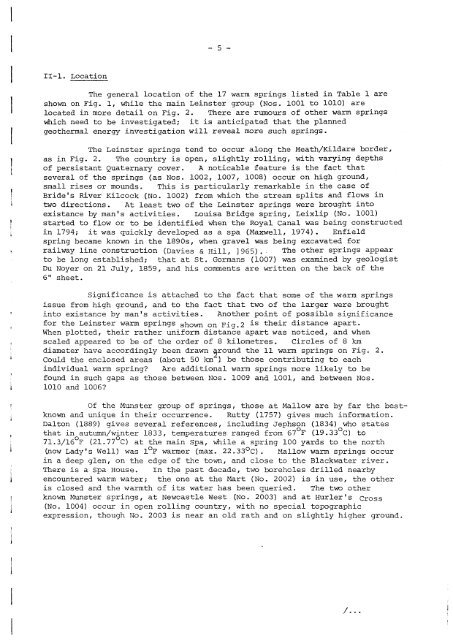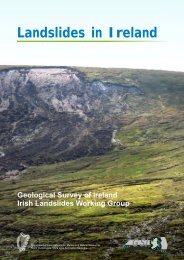Hydrogeothermal Conditions in Ãire - Geological Survey of Ireland
Hydrogeothermal Conditions in Ãire - Geological Survey of Ireland
Hydrogeothermal Conditions in Ãire - Geological Survey of Ireland
You also want an ePaper? Increase the reach of your titles
YUMPU automatically turns print PDFs into web optimized ePapers that Google loves.
- 5 -II-l. LocationThe general location <strong>of</strong> the 17 warm spr<strong>in</strong>gs listed <strong>in</strong> Table 1 areshown on Fig. 1, while the ma<strong>in</strong> Le<strong>in</strong>ster group (Nos. 1001 to 1010) arelocated <strong>in</strong> more detail on Fig. 2. There are rumours <strong>of</strong> other warm spr<strong>in</strong>gswhich need to be <strong>in</strong>vestigated; it is anticipated that the plannedgeothermal energy <strong>in</strong>vestigation will reveal more such spr<strong>in</strong>gs.The Le<strong>in</strong>ster spr<strong>in</strong>gs tend to occur along the Meath/Kildare border,as <strong>in</strong> Fig. 2. The country is open, slightly roll<strong>in</strong>g, with vary<strong>in</strong>g depths<strong>of</strong> persistant Quaternary cover. A noticable feature is the fact thatseveral <strong>of</strong> the spr<strong>in</strong>gs (as Nos. 1002, 1007, 1008) occur on high ground,small rises or mounds. This is particularly remarkable <strong>in</strong> the case <strong>of</strong>Bride's River Kilcock (No. 1002) from which the stream splits and flows <strong>in</strong>two directions. At least two <strong>of</strong> the Le<strong>in</strong>ster spr<strong>in</strong>gs were brought <strong>in</strong>toexistance by man's activities. Louisa Bridge spr<strong>in</strong>g, Leixlip (No. 1001)started to flow or to be identified when the Royal Canal was be<strong>in</strong>g constructed<strong>in</strong> 1794; it was quickly developed as a spa (Maxwell, 1974). Enfieldspr<strong>in</strong>g became known <strong>in</strong> the 1890s, when gravel was be<strong>in</strong>g excavated forrailway l<strong>in</strong>e construction (Davies & Hill, ]965).. The other spr<strong>in</strong>gs appearto be long established; that at St. Germans (1007) was exam<strong>in</strong>ed by geologistDu Noyer on 21 July, 1859, and his comments are written on the back <strong>of</strong> the6" sheet.Signi!icance is attach.ed to the fact that some <strong>of</strong> th.e warm spr<strong>in</strong>gsissue from high ground, and to the fact that two <strong>of</strong> the larger were brought<strong>in</strong>to existance by man's activities. Another po<strong>in</strong>t <strong>of</strong> possible significancefor the Le<strong>in</strong>ster warm spr<strong>in</strong>gs shown on Fig.2 is their distance apart.When plotted, their rather uniform distance apart was noticed, and whenscaled appeared to be <strong>of</strong> the order <strong>of</strong> 8 kilometres. Circles <strong>of</strong> 8 kmdiameter have accord<strong>in</strong>gly been drawn ~round the 11 warm spr<strong>in</strong>gs on Fig. 2.Could the enclosed areas (about 50 km ) be those contribut<strong>in</strong>g to each<strong>in</strong>dividual warm spr<strong>in</strong>g? Are additional warm spr<strong>in</strong>gs more likely to befound <strong>in</strong> such gaps as those between Nos. 1009 and 1001, and between Nos.1010 and 1006?Of the Munster group <strong>of</strong> spr<strong>in</strong>gs, those at Mallow are by far the bestknownand unique <strong>in</strong> their occurrence. Rutty (1757) gives much <strong>in</strong>formation.Dalton (1889) gives several references, <strong>in</strong>clud<strong>in</strong>g Jephson (1834) who statesthat <strong>in</strong> autumn/w<strong>in</strong>ter 1833, temperatures ranged from 67 0 F (19.33 0 C) to .71.3/16 o F (2l.77 o C) at the ma<strong>in</strong> Spa, while a spr<strong>in</strong>g 100 yards to the north~ow Lady's Well) was lOF warmer (max. 22.33 0 C). Mallow warm spr<strong>in</strong>gs occur<strong>in</strong> a deep glen, on the edge <strong>of</strong> the town, and close to the Blackwater river.There is a Spa House. In the past decade, two boreholes drilled nearbyencountered warm water; the one at the Mart (No. 2002) is <strong>in</strong> use, the otheris closed and the warmth <strong>of</strong> its water has been queried. The two otherknown Munster spr<strong>in</strong>gs, at Newcastle West (No. 2003) and at Hurler's Cross(No. 1004) occur <strong>in</strong> open roll<strong>in</strong>g country, with no special topographicexpression, though No. 2003 is near an old rath and on slightly higher ground./ ...
















